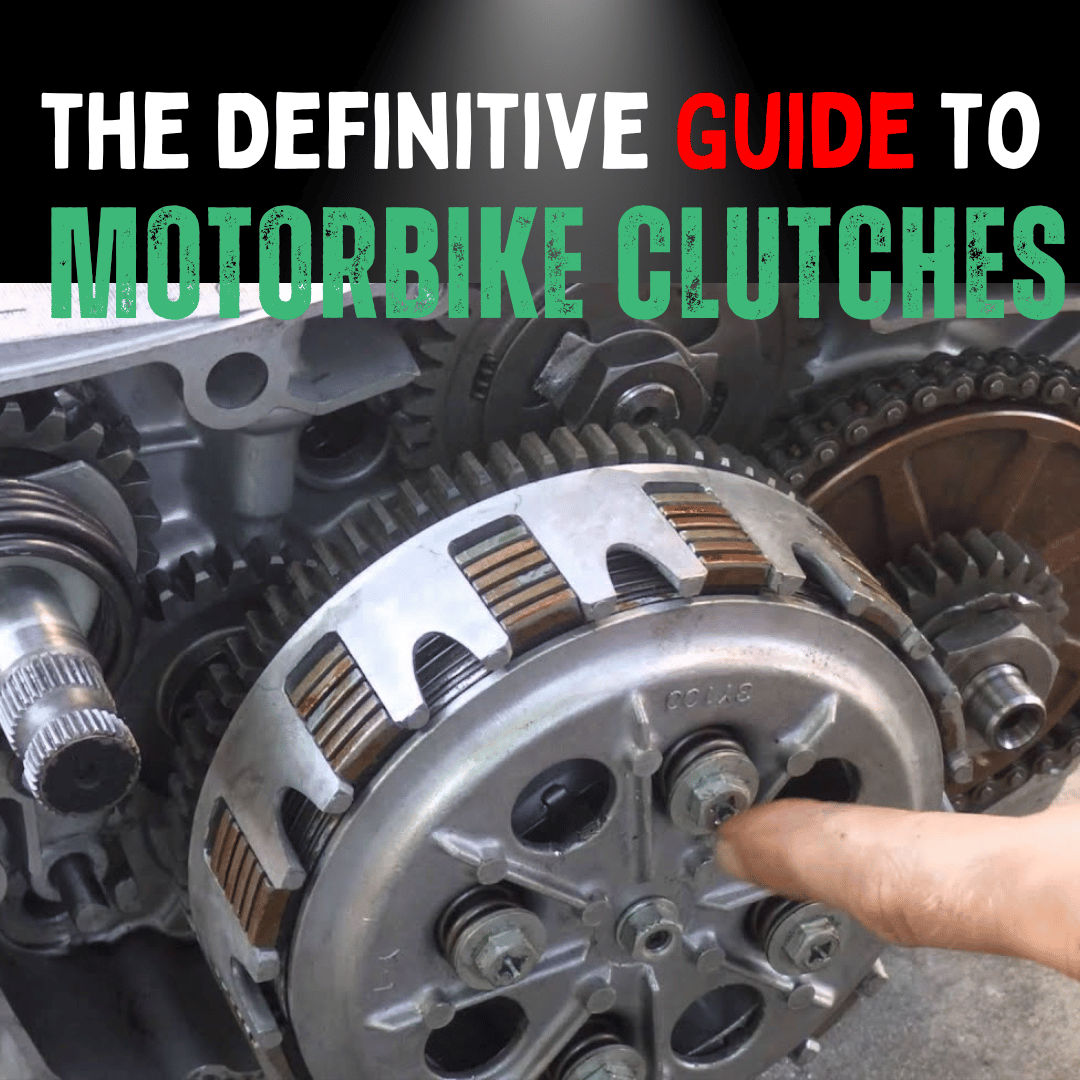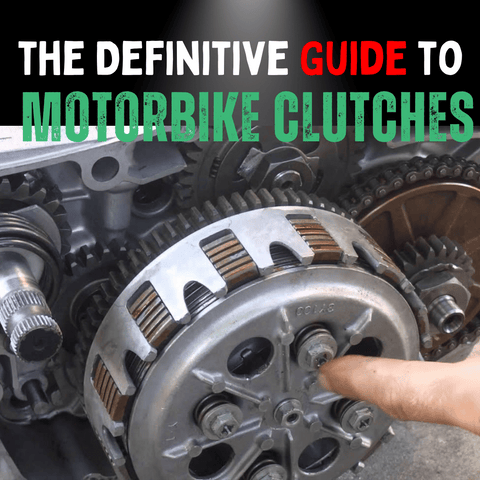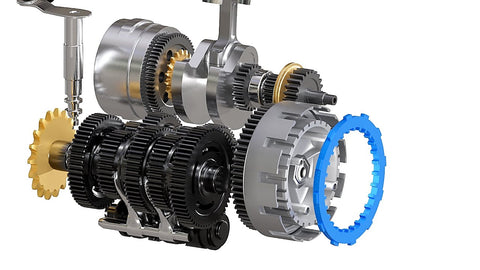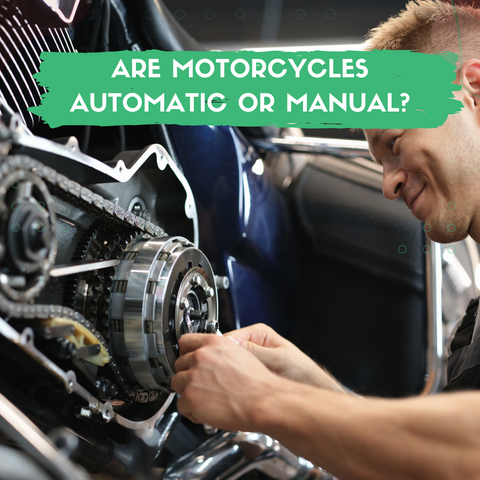
The Definitive Guide to The Different Types of Motorbike Clutches

So, you've got yourself a motorbike. It’s not just any piece of machinery; it's an intricate puzzle where every component plays a vital role.
Right at the heart of this incredible machine is the clutch, a key player in your bike's performance and your riding experience.
If you're itching to find out what makes each type of clutch unique or simply looking to make an informed decision about a clutch upgrade, you've landed on the right page.
We're diving deep into everything you need to know about motorbike clutches, so let’s kickstart this ride.
Understanding the Basics
How Does a Motorcycle Clutch Work?
When you engage the clutch lever, the clutch assembly activates, allowing you to change gears smoothly.
At the heart of this assembly is the engine crankshaft, which transfers engine power to the transmission in your motorcycle.
The transmission then uses this power to change the speed of your motorcycle efficiently.
The clutch components, specifically the pressure plate, help disengage the engine from the transmission, allowing you to change gears.
When you release the clutch lever, the pressure plate re-engages, and power from the engine smoothly transfers through the transmission to your motorcycle's gears.
The clutch lever is your primary interface for engaging or disengaging the clutch assembly.
The lever is connected to a cable or a hydraulic system that affects the pressure plate and other clutch components.
By understanding the mechanism behind it, you can better manipulate the power and torque sent to your motorcycle's rear wheel.
Types of Motorbike Clutches Summarised

| Type of Clutch | Description | Common Applications |
|---|---|---|
| Wet Clutch | Uses oil to cool and lubricate | Road bikes |
| Dry Clutch | No lubricating oil, runs dry | Racing bikes |
| Slipper Clutch | Reduces engine braking effects | High-performance bikes |
| Multi-Plate Clutch | Multiple clutch plates for better torque | Most modern motorcycles |
| Centrifugal Clutch | Engages with increasing engine RPM | Scooters, small-displacement bikes |
| Semi-Automatic Clutch | Automatically disengages during gear shifts | Beginner bikes, small scooters |
| Hydraulic Clutch | Uses hydraulic fluid for operation | Touring bikes, heavy-duty bikes |
| Cable-Operated Clutch | Operated through a cable mechanism | Older bikes, classic models |
| Coil Spring Clutch | Uses coil springs for tension | Road bikes, general use |
| Diaphragm Spring Clutch | Uses a single diaphragm spring | Heavy-duty motorcycles |
| Constant-Mesh Clutch | Keeps all gears meshed at all times | Racing bikes, advanced sport bikes |
| Dog Clutch | Interlocking gear mechanism | Specialised applications, vintage bikes |
Types of Motorbike Clutches
Ever wonder why one bike feels different to ride compared to another?
A lot of that has to do with the type of clutch it uses. Each has its own set of advantages, disadvantages, and best-use scenarios. Let’s explore them.
1. Wet Clutch
These clutches are bathed in engine oil, reducing friction and providing smoother operation.
They are a common application in most types of motorcycles. Friction is reduced, making it easier to use gears to change speed.
Advantages: Less wear and tear, lower heat generation, smoother operation.
Disadvantages: Requires regular maintenance.
Best Suited For: Almost all types of bikes.
2. Dry Clutch
A dry clutch is mostly found in performance-oriented bikes. It has friction plates and disc plates in its clutch assembly that are not bathed in lubricating oil.
Due to the lack of lubrication, they tend to create a unique sound. They can handle a large amount of power from the motorcycle engine but require frequent maintenance.
Advantages: Less slippage, quicker power transfer.
Disadvantages: More noise, greater wear and tear.
Best Suited For: High-performance bikes.
3. Multi-Plate Clutch
These are the ubiquitous clutches, found in a variety of bikes, consisting of multiple friction and steel plates.
Advantages: High torque handling, reliable.
Disadvantages: May require frequent adjustments.
Best Suited For: General-purpose motorcycles.
4. Slipper Clutch
The saviour in racing scenarios, this clutch prevents the rear wheel from locking up during aggressive downshifts.
Advantages: Avoids wheel hop during quick deceleration.
Disadvantages: More complex, expensive.
Best Suited For: Racing motorcycles.
5. Centrifugal Clutch
This no-fuss clutch engages and disengages using centrifugal force, perfect for scooters and smaller bikes.
Advantages: Simple, low-maintenance.
Disadvantages: Limited performance.
Best Suited For: Small motorcycles and scooters.
6. Hydraulic Clutch
The clutch for the adrenaline junkies. Common in high-performance bikes.
Advantages: Smooth operation, less manual effort.
Disadvantages: Can be costly to repair.
Best Suited For: High-performance bikes.
7. Cable Clutch
The nostalgic choice, often found in older motorcycles.
Advantages: Easy to repair, budget-friendly.
Disadvantages: Requires regular adjustments and lubrication.
Best Suited For: Older or vintage motorcycles.
8. Electromagnetic Clutch
The future is here with this clutch that uses electromagnetic fields for operation.
Advantages: Minimal maintenance, highly efficient.
Disadvantages: Limited torque capacity, can be expensive.
Best Suited For: Scooters and some small motorcycles.
9. Dog Clutch
The performance beast, mainly seen in racing motorcycles.
Advantages: Extremely quick shifts, high durability.
Disadvantages: Not suitable for casual riding, can be abrupt.
Best Suited For: Racing motorcycles.
10. Single Plate Clutch
The simplified version often found in cars, but also in some light motorcycles.
Advantages: Simple design, easier maintenance.
Disadvantages: Limited torque capacity.
Best Suited For: Cars and light vehicles, less common in motorcycles.
11. Multi-Plate Clutch
This type of clutch takes the single plate concept and multiplies it, literally, with more than one friction plate.
Advantages: Greater torque transfer, highly efficient.
Disadvantages: Can be complex, higher maintenance needs.
Best Suited For: High-performance bikes, heavy-duty applications.
12. Cone Clutch
Old but gold, the cone clutch is rarely seen in modern bikes but has its niche.
Advantages: High torque capacity due to increased surface area.
Disadvantages: Less smooth, often outdated.
Best Suited For: Specialised applications, older models.
Related: Are Motorcycles Automatic or Manual?
Understanding Energy Transfer in Motorcycle Clutches
Your motorcycle engine is a powerhouse that converts energy into force.
The clutch acts as a mediator, facilitating the transfer of this force from the engine's rotating mass to the transmission.
In essence, the clutch serves as an energy storage mechanism, allowing you to change gears and control speed effectively.
Related: 10 Ways To Avoid Your Motorcycle Clutch From Burning Out
Varieties of Materials Used in Clutch Plates
Different kinds of materials are used in the friction plates and disc plates of a clutch.
The type of material can affect resistance, rubbing, and the overall functionality of the clutch in your automobile.
Some common materials include cork, ceramic, and organic compounds.
| Material Type | Composition | Characteristics | Best For |
|---|---|---|---|
| Cast Iron | Iron | High compressive strength | General use |
| High Carbon Steel | Carbon Steel | Strength and durability | General use |
| Ceramic | Copper, Iron, Bronze, Silicon, Graphite | High friction and heat resistance | High-performance motorcycles |
| Organic | Sintered Bronze, Ceramic Material, Copper, Tin, Iron, Silicon Dioxide, Carbon | Smooth engagement | OEMs |
| Kevlar | Kevlar fibers | High durability and resistance to wear | High-performance motorcycles |
| Feramalloy | Proprietary material | Wear and temperature resistance, smooth engagement | Newer, high-performance motorcycles |
Choosing the Right Clutch
Selecting the appropriate clutch is crucial for the functionality and utilisation of your bike's transmission and gears.
Your riding style and the type of motorcycle you own will greatly influence your choice.
Keep these tips in mind:
-
Match the Bike: Different bikes need different clutches. A sport bike might benefit from a slipper clutch, while a scooter usually employs a centrifugal clutch.
-
Know Your Riding Style: Whether you're into off-roading or city cruising, your riding style dictates the clutch type best suited for you.
-
Understand Clutch Types: From wet to electromagnetic clutches, each has unique traits suited for specific bikes and riding conditions.
-
Consult Experts: When in doubt, get advice from professionals like mechanics or dealers to ensure a perfect fit for your riding style and bike type.
Maintenance and Troubleshooting
Your clutch components need regular check-ups to ensure optimal performance.
This includes inspecting the clutch cable for wear and making necessary adjustments for the right amount of free play.
Maintenance Tips
-
Inspect the Clutch Cable: Regularly examine the cable for any signs of damage, such as cracks, kinks, or corrosion. The common recommendation in most service manuals is to inspect after every race or every 2.5 hours of operation.
-
Adjust the Cable: It’s essential to adjust the clutch cable for the correct amount of free play. Always refer to your factory repair manual for precise guidance on this.
-
Review Clutch Plates: Periodically check for wear and tear on the clutch plates. Worn-out plates will need replacing to ensure optimal performance.
Troubleshooting Guidelines
Issues with the clutch assembly could lead to poor functionality. Problems can range from clutch slippage to inconsistent operation.
Regularly checking the clutch plates, pressure plate, and clutch springs can save you from future headaches.
-
Clutch Cable Adjustments: Incorrect cable adjustment can result in poor clutch control, slippage, or inconsistent operation. Make sure it's well-adjusted.
-
Examine the Clutch Release Lever: Ensure that both the clutch release lever and the cable have the correct amount of free play. Incorrect levels could lead to various operational issues.
-
Evaluate the Clutch Plates: Worn-out clutch plates can lead to issues like slipping or difficulties in shifting gears. If you experience such problems, it’s likely time for a replacement.
-
Inspect Clutch Springs: Weak or broken clutch springs can also cause gear slipping or shifting problems. If you face such issues, check the springs and replace them if needed.
How to Identify Wear and Tear
Recognising the signs of wear and tear early on can save you from major repair costs and ensure your safety.
Here are some telltale signs:
- Slipping Gears: If your bike is slipping out of gear without any input from you, this could indicate worn clutch plates.
- Difficulty in Shifting: If shifting gears has become a Herculean task, this might be a sign of wear.
- Strange Noises: A rattling or scraping sound could indicate that something's amiss.
- Weak Acceleration: If the engine revs, but the bike doesn’t accelerate as it should, the clutch could be wearing out.
Regularly inspect your clutch and its components to catch these issues early on.
Common Clutch Issues and Their Solutions
Slipping Clutches
A car's clutch can start to slip due to worn-out friction plates or a weak pressure plate.
Replacing these clutch components should solve the problem.
Difficulty in Gear Shifting
If your automobile or auto is struggling with gear changes, it could be due to a poorly adjusted clutch cable or issues with the transmission's spindle or axle.
Estimated Costs for Replacement and Maintenance
Based on our research, here's what you can expect to pay for clutch replacement and maintenance:
-
Clutch Replacement: The cost generally varies based on your bike's make and model, the type of clutch, and where you're getting the service. On average, expect to pay between £300 and £1000, with most people shelling out between £400 and £800. This includes both parts and 2-3 hours of labour.
-
Clutch Maintenance: The costs here depend on the maintenance type. For instance, adjusting the clutch cable is a relatively low-cost affair that you can often do yourself. If you need to replace the clutch plates, however, prices can range from £60 to £500, depending on your bike's make and model.
Remember, routine checks and timely troubleshooting can save you from larger issues down the road.
| Category | Estimated Cost Range | Additional Information |
|---|---|---|
| Clutch Replacement | £300 to £1000 | Includes parts and 2-3 hour labor |
| Clutch Maintenance (Cable Adjustment) | Minimal Cost | Can be done at home |
| Clutch Maintenance (Plate Replacement) | £60 to £500 | Cost varies by make and model |
Always consult your service manual for model-specific advice.
How Clutches Impact Overall Bike Performance
Choosing the right type of clutch is not just about ensuring smooth gear shifts; it can also have a broader impact on your bike’s overall performance.
- Fuel Efficiency: Some types of clutches are designed to offer better fuel efficiency.
- Acceleration and Speed: A high-performance clutch can result in better acceleration, making a difference in how the bike feels when you open up the throttle.
- Riding Comfort: The right clutch can provide a smoother, more comfortable ride, making your biking experience far more enjoyable.
By considering how each type of clutch impacts these aspects, you can make a more informed decision that enhances your entire riding experience.
How to Safely Utilise Clutch During Different Riding Conditions
Off-Road Riding
When you're taking your vehicle off the beaten path, the traction under your tyres becomes paramount.
Knowing how to feather your clutch lever can help you maintain control when the terrain gets challenging.
City Riding
In stop-and-go traffic, understanding your clutch's function can help you navigate through roads smoothly, reducing wear and tear on the vehicle's motor.
FAQs
What are the Signs of a Failing Motorcycle Clutch?
If you experience intense vibrations or pulsations while using the clutch or shifting gears, or if your motorcycle shudders notably when you start moving or let go of the clutch after a shift, it's time to get your clutch checked. These symptoms often point to a malfunctioning clutch that needs immediate attention.
Can a Motorcycle Run Without a Clutch?
Most motorcycles can upshift without using the clutch by simply shifting firmly. For downshifting, you can either slow down until the engine starts to lug and then make a firm shift, or use a quick "blip" of the throttle before downshifting to unload the transmission gears. However, riding this way is not recommended for extended periods.
What Happens When You Use the Wrong Type of Clutch for Your Motorcycle?
Using the wrong type of clutch can significantly impact your motorcycle's performance. In particular, you may experience reduced fuel efficiency as the engine struggles to transmit power correctly to the gearbox. This inefficiency can lead to decreased acceleration and speed, ultimately affecting your bike's mileage.
Can I Customise My Motorcycle Clutch for Better Performance?
Yes, you can customise your motorcycle clutch for enhanced performance. Aftermarket parts offer the opportunity to fine-tune your bike's performance to better meet your personal standards. If you're already planning repairs on your clutch, it's an ideal time to explore these aftermarket options.
Get in Touch 🚀
Loved our article on “The Definitive Guide to Different Types of Motorbike Clutches” Got the itch to dive into more wheely-awesome info?
Whether you're a parent or a grandparent, we're here for all your kids ride-on toy questions! 🚗💨
Feeling click-happy?
Jump straight into our wonderland at RiiRoo.com.
Or, if you're more the chatty type, give our Live Chat a whirl and let's talk toys!


